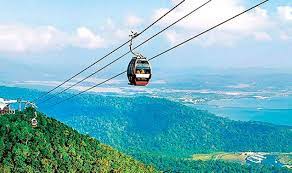09 Feb 2022 National Ropeway Development Program- “Parvatmala”

- Recently, the Union Finance Minister has announced the National Ropeway Development Program- “Parvatmala” in the Union Budget for the year 2022-23 to improve connectivity in hilly areas.
About Parivamala Yojana:
- The scheme will be launched in PPP (Public Private Partnership) mode, which will be an ecologically sustainable alternative to traditional roads in difficult hilly areas.
- It deals with promoting tourism as well as improving connectivity and convenience for travelers.
- It can also include those congested urban areas where traditional public transport system is not possible.
- This scheme is currently being launched in Uttarakhand, Himachal Pradesh, Manipur, Jammu and Kashmir and other North Eastern states.
- The Finance Minister has announced that in the year 2022-23, 60 km. Contracts for 8 ropeway projects will be awarded for the length.
Nodal Ministries:
- The Ministry of Road Transport and Highways (MoRTH) will have the responsibility of construction, research and policy development along with ropeway and alternative mobility solution technology in the region.
- The Government of India (Allocation of Business) Rules 1961 were amended in February 2021, which enabled MORTH to look after the development of Ropeways and Alternate Mobility Solutions.
- This move will give a boost to the sector by establishing a regulatory regime.
- ‘MORTH’ has so far been responsible for the development of highways across the country and regulating the road transport sector.
Importance:
Economical mode of transport:
- Considering that the ropeway projects are built in a straight line in hilly terrain, it also reduces the cost of land acquisition.
- Therefore, per km as compared to roadways. Despite the higher cost of construction, the construction cost of ropeway projects can be more economical than that of roadways.
Fast mode of transport:
- Ropeway is quite advantageous as compared to road projects due to aerial mode of transport, as ropeway can be constructed in a straight line in hilly terrain.
Environmentally friendly:
- It has low dust emission. The containers of the respective material may be designed in such a way as to avoid any contamination in the environment.
Full Connectivity:
- Ropeway projects adopting ‘3S’ (a specific type of cable car system) or equivalent technologies can transport 6000-8000 passengers per hour.
Ideal for challenging/sensitive terrain:
- Long Rope Span: In this system obstacles like rivers, buildings, ravines or roads can be crossed without any problem.
- Ropes guided on towers: Requires little ground space and no obstructions to humans or animals.
Economy:
- The ropeway consists of multiple cable cars operated by a single power-plant and drive mechanism.
- It reduces the cost of both construction and maintenance.
- Use of single operator in ropeway will reduce labor cost.
- The cost of a ropeway on flat land is competitive with narrow-gauge railroads, while the ropeway is far better in the mountains.
Flexible:
- Transportation of different materials- A ropeway can simultaneously transport different types of materials.
Ability to handle large slopes:
- Ropeways and cable-ways (cable cranes) can handle large slopes and large differences in height.
- Where a road or railroad requires switchbacks or tunnels, the ropeway travels directly up and down the fall line. In England the Old Cliff Railway and the ski resort ropeway in the mountains take advantage of this facility.
Less Land Required:
- The fact that only narrow base vertical supports are required at intervals, leaving the rest of the land free, makes it possible to build ropeways in built-up areas and in places where there is intense competition for land use.


No Comments